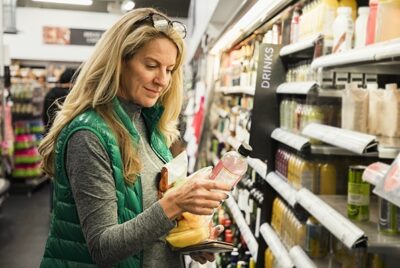It’s that time of year. Holiday shoppers are creating lists and checking them twice, but there are some big differences in when, where and how consumers will spend their hard-earned cash this year.
“Regardless of the holiday, virtually every consumer set does something to celebrate and exchange gifts with their loved ones this time of year,” says Andrew Keenan, executive vice president and general manager, Advantage Solutions, a leading provider of sales and marketing services to consumer goods manufacturers and retailers. “Christmas, Kwanzaa, Hanukkah, whatever it might be, consumers are prepared for year-end spending.”
And many already have begun shopping.
‘Seasonal creep’
Thanksgiving was once the unofficial start of the holiday shopping season, but shoppers now begin filling their carts much earlier thanks to consumer and retailer behaviors that shifted during the pandemic. Retailers aggressively extended holiday merchandising and promotions to capture consumers’ stay-at-home attention, and shoppers are still responding today.
“One large nationwide retailer began selling inflatable skeletons in July, well in advance of the Halloween season, and they sold out quickly,” says Keenan. “And grocery retailers didn’t wait to get Thanksgiving items out in October. They were placing items in September to maximize every dollar of consumer spend amid economic uncertainty.”
That hyper early-bird mentality is likely to remain common practice for the foreseeable future for the simple reason that consumers are responding — and not just because of enticing displays they see in stores.
Online promotions are grabbing attention as well. Retailers such as Amazon, Walmart and Target kicked off holiday shopping events this year in October — almost two months ahead of Black Friday.
“It starts with the online presence,” Keenan says. “Retailers are pivoting their strategy to attract consumers online to boost virtual shopping well ahead of the season, and they’re creating offers that are only available in-store. The goal is to win both in-store and online.”
Or, even better, retailers want consumers in their stores, on their phones. There, they’re served tailored and targeted promotions that create feelings of exclusivity —aha moments where consumers think, ‘Look! There’s a special deal, and I can act on it now because I’m a preferred customer and there’s an e-coupon just for me,’” Keenan says.
Behind the urge to buy now
FOMO, or “fear of missing out,” isn’t just for TikTokkers. Retailers are also playing on shoppers’ sense of urgency. Some consumers will always push seasonal shopping to the last minute, but there are many others motivated by snagging a deal when they see it in fear the item will be sold-out when they need it. That, Keenan says, is another remnant of the pandemic and the supply-chain concerns it spurred.
“Before the pandemic you would not really see Halloween candy in August, and if you did you wouldn’t think twice — you’d ignore it, thinking, ‘I have time to buy,’” Keenan says. But during the heart of the pandemic, when seemingly everything was sold out — from everyday items like toilet paper to holiday gifts — consumer behavior changed. Today, “there’s a little bit of a chilling effect for higher-income shoppers who buy early because they don’t want to miss out, and price is less important to them.”
The rise of the deal hunters
For many others, however, price is front and center this holiday shopping season, largely due to persistent fears of inflation.
More than half of consumers shopping for holiday celebrations expect inflation and other economic concerns to affect their holiday spending, according to a newly released Advantage Pulse survey that surveyed 1,000 U.S. adults.
As a result, Keenan expects more channel-shifting, largely benefiting discounters and value retailers.
“It’s the rise of what has been called extreme-value retail,” he says. “There’s a perception that only lower-income shoppers and families are shopping in the value channel, and that’s not always true.”
Value retailers that traditionally have focused on offering general merchandise at deep discounts have found success pivoting into food and other categories. And even if the price they charge for grocery staples is similar to what consumers may find elsewhere, they’re buying anyway because of the perception of value.
“Shoppers are being offered products they didn’t think they could get at a value retailer, and they’re able to buy a wider product assortment and do so on fewer shopping trips,” says Keenan. “That’s something that we’ll continue to see, and it’s part of why these value banners are growing.”
Those retailers are no longer just drawing families trying to make ends meet who are looking for the best deal. They’re appealing to a broader consumer set, including a growing population of higher-income earners who also want to take advantage of competitive pricing.
That’s causing retailers and consumer packaged goods companies to rethink their customer segmentation and promotional strategies, Keenan says. That may mean offering a wider variety of products across segments or assembling sales bundles that offer consumers more value.
In-store execution is key
Preference for a great deal aside, consumers are expected to continue spending this holiday season. Many of Advantage Solutions’ retail customers across categories and channels are planning for moderate sales growth over 2022, Keenan says.
Retailers seeking to get their fair share of the holiday pie must focus on in-store execution. Paramount is ensuring on-shelf availability.
Keenan, whose role at Advantage includes overseeing in-store execution, says when stores aren’t rigorous in their efforts to ensure that merchandise is available, visible on the shelf and in the right location, customers will simply go elsewhere.
Even worse, he says, is when retailers miss out on a potential sale because products are marooned in the back room or aren’t where they belong on shelf.
“In-store product conditions have never been more important, and the challenge to improve product availability is very real,” he says. “The labor market has shifted so dramatically; it’s harder than ever to maintain capable help to provide this critical execution. It’s a meaningful opportunity across categories and channels. Our industry has to identify new ways to solve that problem together.




